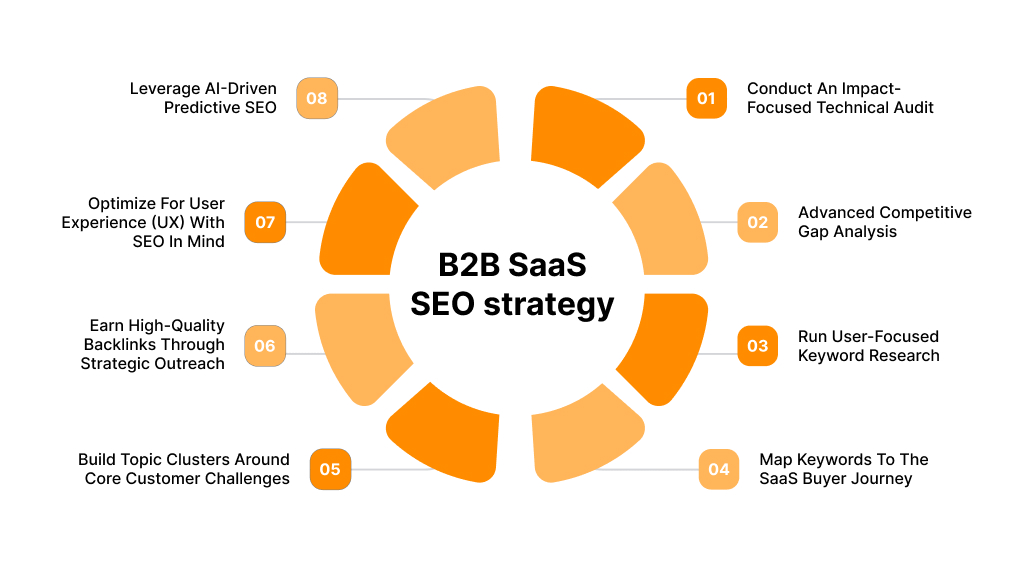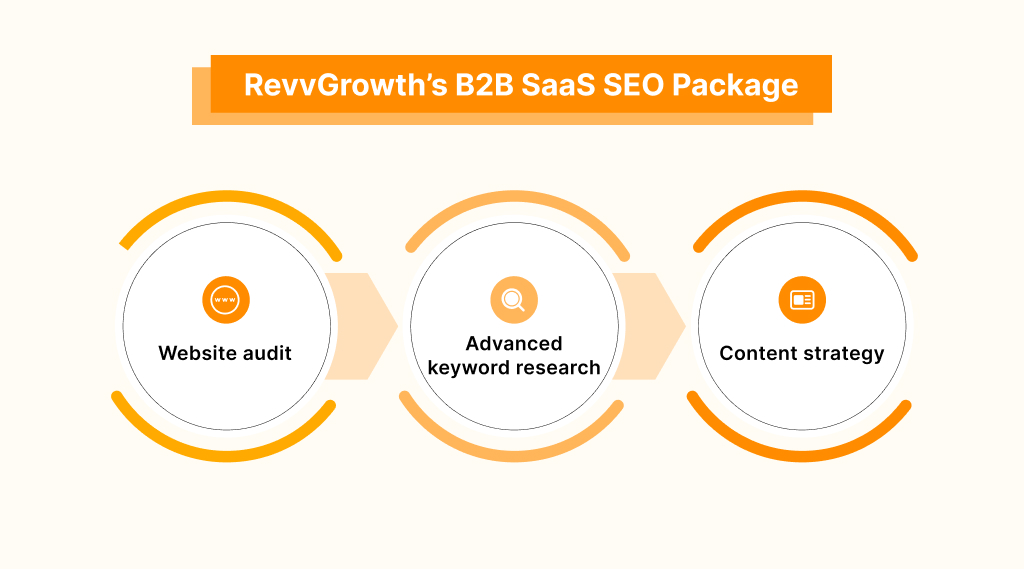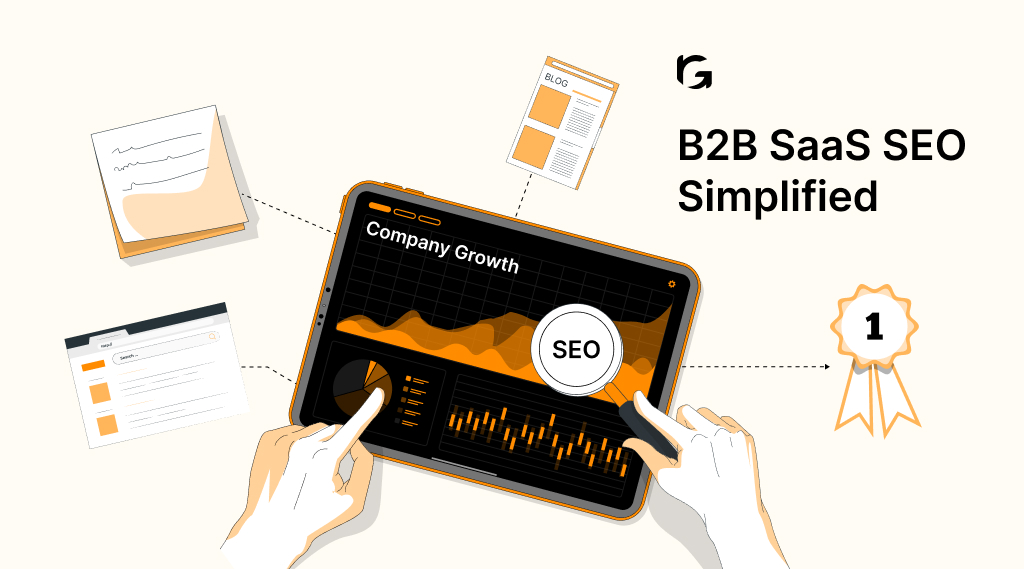I often get asked, “Hey Tahir, is SEO dead?” and my answer is always the same: “No, mate, it’s just evolving.” But how exactly is it evolving? SEO isn’t just about ranking on Google anymore. Today, your content needs to perform across platforms like ChatGPT, Perplexity, Reddit, and more—not just Google. Why? Because search itself is changing. People aren’t solely relying on Google to make buying decisions; they’re using a variety of tools and platforms. That’s why it’s crucial to optimize for multiple “search engines” to stay ahead.
But let’s be honest: SEO for SaaS companies isn’t always straightforward. It’s a multi-layered strategy that can seem overwhelming, especially when juggling a hundred other priorities. Yet, mastering SEO for B2B SaaS can position your product right where these decision-makers are looking, giving you the edge over competitors. In this blog, I’ll strip away the complexity and give you a clear, actionable plan to make SEO work for your B2B SaaS company.
Is SEO done differently for SaaS companies?
Absolutely, SEO for SaaS companies is a different ball game, and here’s why. When dealing with software as a service, your potential customers’ mindset is unique. They’re not just purchasing a product; they’re committing to a solution that needs to integrate seamlessly into their business operations. This makes the SEO strategy for SaaS companies distinct from other industries.
1. Targeting the customer funnel
In SaaS, your prospects are at different stages of their buying journey. SEO needs to address awareness, consideration, and decision stages by optimizing content that guides them seamlessly from one stage to the next. This includes focusing on high-impact pages like pricing, free trials, and demo sign-ups, which are crucial for conversions.
2. Fast sales cycle
SaaS products, especially those priced under $5,000, often have a sales cycle as short as 40 days. SEO needs to be highly effective in quickly attracting and converting leads who are already close to making a purchase decision. This means targeting high-intent keywords and creating content that drives immediate action.
3. Subscription-based model
The SaaS business model relies on long-term customer relationships. SEO plays a critical role not just in acquiring new customers but also in retaining them. By focusing on content that continues to engage and add value to existing customers, SEO helps reduce churn and increase lifetime value.
4. Targeting decision-makers
Unlike many other industries, SaaS often involves selling to business decision-makers. Your SEO strategy must create content that directly addresses their concerns, demonstrating how your software can solve specific business problems and deliver ROI.
5. Varied customer profiles
SaaS companies often serve a mix of B2B, B2C, and B2B2C customers, each with distinct needs and search behaviors. SEO must be tailored to meet the expectations of these varied audiences, ensuring your content is relevant and appealing to each customer profile.
6. Global competition
SaaS is inherently global, and your SEO strategy needs to reflect this. Optimizing for international markets by considering different languages, cultural nuances, and local search behaviors ensures your product is discoverable and competitive across borders.
7. Optimizing for conversion
SEO isn’t just about getting eyes on your site; it’s about converting those visitors into paying customers. This involves crafting content that’s not only optimized for search engines but also tailored to engage and persuade your target audience, turning interest into action.
SEO for SaaS is not just about visibility; it’s about strategically guiding potential customers through their journey, addressing their unique needs, and ultimately turning them into loyal, long-term subscribers.
An 8-step action plan to create your own B2B SaaS SEO strategy
When it comes to B2B SaaS SEO, I know it can feel overwhelming, but it doesn’t have to be. Let me walk you through an 8-step plan that I use to attract the right audience and turn them into loyal customers.

1. Conduct an impact-focused technical audit
Before diving into content and keywords, let’s ensure your website’s engine is running smoothly. Start by looking at your site’s speed—did you know that even a one-second delay can reduce conversions by 7%? Tools like Google PageSpeed Insights help you pinpoint what’s slowing you down, from large images to inefficient code.
Next, consider crawlability. Search engines must navigate your site without hitting roadblocks like broken links or duplicate content. You can identify and fix these issues using Screaming Frog or Google Search Console to ensure your site is fully indexed.
Finally, mobile-friendliness isn’t just a nice-to-have; it’s a necessity. With mobile traffic accounting for over half of all web traffic, your site must be seamless across devices. If your mobile site isn’t up to par, you lose visitors and search rankings.
2. Advanced competitive gap analysis
To outshine your competitors, start by identifying the gaps they’re leaving behind. Use tools like Ahrefs or SEMrush to compare your site against theirs, focusing on keywords they rank for but haven’t fully optimized. These overlooked opportunities are your chance to create more relevant, in-depth content.
Don’t forget to analyze their backlinks and spot quality sites linking to them that you could target too. Securing these backlinks can boost your authority and help you leapfrog competitors in search rankings.
You can strategically position your SaaS business to capture more traffic and improve your SEO standing by filling these gaps in content, keywords, and backlinks.
3. Run user-focused keyword research
Keyword research should be centered around user intent, not just search volume. Use tools like SEMrush and Ahrefs to identify potential keywords, then pair these with insights from user behavior tools like Hotjar.
For example, where do they click most? Which pages lead to conversions? This helps you find keywords that match users’ searches and what drives them to act.
Prioritize long-tail keywords; they’re more specific and often signal a user who’s closer to making a decision. By aligning keywords with user behavior, you create content that attracts the right audience and boosts conversions.
4. Map keywords to the SaaS buyer journey
Mapping keywords to the SaaS buyer journey ensures your content speaks to prospects at every stage, from awareness to decision. Start by categorizing your keywords into three groups: top-of-funnel (awareness), mid-funnel (consideration), and bottom-of-funnel (decision).
Top-of-funnel keywords might include broad terms like “best project management software,” targeting users just starting their search. Mid-funnel keywords, such as “project management tools for small teams,” are more specific, addressing users’ comparison of options. Bottom-of-funnel keywords focus on action, like “buy [your software name]” or “sign up for [your software name] free trial.”
By aligning your keywords with each journey stage, you guide prospects smoothly from discovery to purchase, increasing the likelihood of conversions.
5. Build topic clusters around core customer challenges
Topic clusters are essential for building authority in SEO, especially when addressing the specific challenges your SaaS product solves. Start by identifying the core issues your customers face, then create a pillar page that offers a comprehensive overview of the topic.
For instance, if your SaaS product helps with remote team management, your pillar page could cover everything from communication tools to productivity tracking. Surround this pillar with related, in-depth articles such as “best practices for managing remote teams” or “tools to enhance remote collaboration.”
Interlink these articles to the pillar page, reinforcing your site’s authority. This structure boosts your search rankings and ensures users find valuable, interconnected content that addresses their needs.
6. Earn high-quality backlinks through strategic outreach
Let’s talk about backlinks the kind that makes a difference. You need links from reputable, industry-relevant sites to boost your site’s authority. Start using tools like Ahrefs or Moz to find websites that link to your competitors but haven’t yet discovered your content.
Next, create unique content, original research, actionable insights, or comprehensive guides. When you reach out, don’t just send a generic email. Personalize your pitch, explaining exactly why your content would add value to their site.
Guest blogging on respected industry sites is also a smart move. It earns you valuable backlinks and positions you as an expert in your field, which can further enhance your SEO efforts.
7. Optimize for User Experience (UX) with SEO in mind
User experience (UX) and SEO are two sides of the same coin. Google’s Core Web Vitals now emphasize loading performance, interactivity, and visual stability metrics. Studies have shown that 53% of mobile users abandon sites that load over three seconds. Use tools like Google Lighthouse to monitor these metrics and make necessary adjustments. Crazy Egg can show you how users interact with your site, highlighting areas for improvement.
Also, focus on accessibility by ensuring your site is easy to navigate for all users, including those with disabilities. Implement features like keyboard navigation, alt text for images, and readable font sizes. A well-optimized UX doesn’t just please users; it signals to Google that your site is high-quality, boosting your rankings and driving more organic traffic.
8. Leverage AI-driven predictive SEO
AI-driven predictive SEO is your crystal ball for future search trends. Instead of reacting to trends, AI tools like Clearscope or MarketMuse can be used to anticipate which topics and keywords will gain traction. These tools analyze massive amounts of data to forecast what your audience will be searching for before the competition catches on.
For example, by examining emerging search patterns and related queries, AI can suggest content topics that haven’t yet saturated the market. This allows you to create high-ranking content early, positioning your site as an authority as the topic grows in popularity. You can consistently capture new traffic and maintain a competitive edge by staying ahead of the curve.
Looking For SaaS SEO Agency to Work With? Here is What We Offer:

At RevvGrowth, we understand that a one-size-fits-all approach doesn’t work for B2B SaaS companies. Our SEO package is uniquely crafted to cater to your business’s specific requirements, guaranteeing that every aspect of your online presence is optimized for success. Here’s what we offer:
1. Website audit
We thoroughly assess your website’s current performance to identify areas for improvement. We also analyze your site’s traffic and user behavior to see how visitors interact with your content.
Then, we dive into your site’s architecture, checking for issues like broken links or crawl errors that might hurt your rankings. Finally, we review your site’s speed, mobile-friendliness, and SEO elements like meta tags and headers to ensure everything is optimized.
2. Advanced keyword research
We prioritize identifying and concentrating on the most pertinent keywords to draw in specific traffic to your website. We start by compiling a broad list of potential keywords your audience might use in their searches.
Using tools like Google Keyword Planner and SEMrush, we explore high-volume and niche keywords that align with your goals. We then refine this list, focusing on keywords with the best potential to drive qualified traffic and support your overall SEO strategy.
7 Advanced Keyword Research Strategies to Boost Your SEO Game in 2024
3. Content strategy
We aim to generate and enhance content that performs well in search results and connects with your target audience. We start with a content audit to identify what’s working and where there are gaps.
Based on these insights and our keyword research, we develop a content plan that includes blog posts, case studies, and other resources. We make sure that all content is tailored to improve SEO and curated to engage your audience, guiding them through their journey from discovery to conversion.
This package ensures your B2B SaaS business gets the visibility it deserves, driving meaningful traffic and conversions. If you wish to learn more about our services click on this link
Revv Growth- You’re Go-to B2B SaaS SEO Agency
At Revv Growth, we approach SEO differently, and this unique perspective is what makes us a standout partner for B2B SaaS companies.
1. Specialized SaaS expertise
Unlike many agencies that spread their efforts across multiple industries, we focus solely on SaaS. This specialization deeply explains SaaS companies’ specific SEO challenges, such as balancing user acquisition with retention.
We know your industry inside and out, so our strategies always align with your unique needs.
2. Comprehensive SEO across the Funnel
Our approach goes beyond just attracting traffic to your site. We integrate SEO strategies across the entire customer journey—from awareness to conversion—ensuring that your content, lead nurturing, and conversion efforts are all in sync.
This full-funnel strategy is especially effective in the SaaS space, where the customer journey involves multiple touchpoints.
3. Account-Based SEO (ABSEO)
We’ve pioneered a unique blend of Account-Based Marketing (ABM) and SEO to create what we call Account-Based SEO (ABSEO). This approach targets high-value accounts with tailored SEO content, focusing on reaching key decision-makers within specific companies.
It’s a strategic way to ensure that your SEO efforts are precisely targeted, leading to higher-quality leads.
4. Focus on meaningful engagements
Traffic alone isn’t our end goal. Instead of chasing numbers, we focus on driving meaningful engagements and conversions. Our SEO strategies are designed to align with your business goals—whether that’s increasing sign-ups, securing demo requests, or boosting customer retention—so that every click counts.
5. Collaborative content development
We believe that great SEO comes from collaboration. That’s why we work closely with your in-house teams to develop content strategies that improve SEO and support your overall marketing and product objectives.
This ensures that SEO isn’t working in a silo but is part of a cohesive strategy that drives growth across your entire business.
In essence, Revv Growth is more than just an SEO agency—we’re a partner dedicated to crafting a tailored, results-driven strategy that meets the unique demands of the B2B SaaS industry.
Bottom Line
Imagine transforming your B2B SaaS business with an SEO strategy that drives traffic and converts that traffic into loyal customers. The right SEO approach can be the difference between simply being found and being the top choice in a crowded market. At Revv Growth, we specialize in creating tailored SEO strategies that are designed to do just that—drive meaningful results and fuel your growth.
Ready to elevate your business and leave your competitors behind? Let’s work together to craft an SEO strategy that delivers.
Contact us today and start your journey to success.
FAQs
1. What is B2B SaaS SEO?
B2B SaaS SEO is optimizing a SaaS company’s website to improve visibility, attract targeted traffic, and convert leads in the B2B market.
2. Is SEO effective for B2B?
Yes, SEO is highly effective for B2B, helping businesses reach decision-makers, build authority, and drive qualified leads through organic search.
3. What are SEO and SEM for SaaS?
SEO (Search Engine Optimization) enhances organic search visibility, while SEM (Search Engine Marketing) involves paid advertising to increase traffic and conversions.
4. Why is SEO important for SaaS?
SEO is crucial for SaaS because it drives organic traffic, boosts brand credibility, and supports customer acquisition and retention in a competitive market.
5. How long does it take for SEO to work?
SEO typically takes 3 to 6 months to show significant results, though this can vary depending on the industry’s competitiveness and the strategy used.



